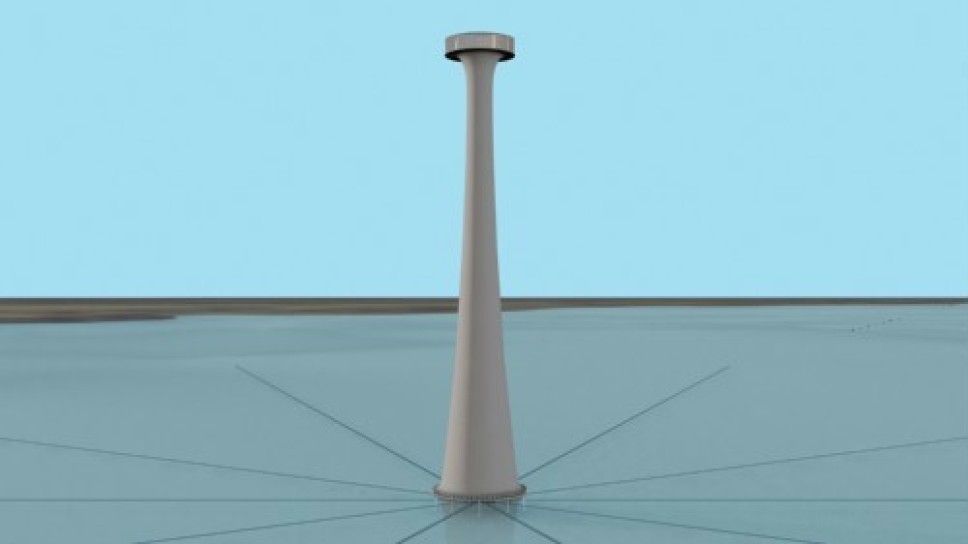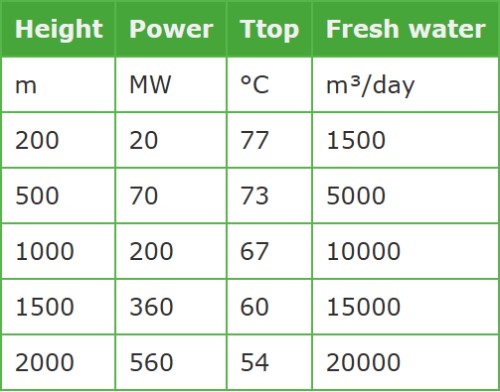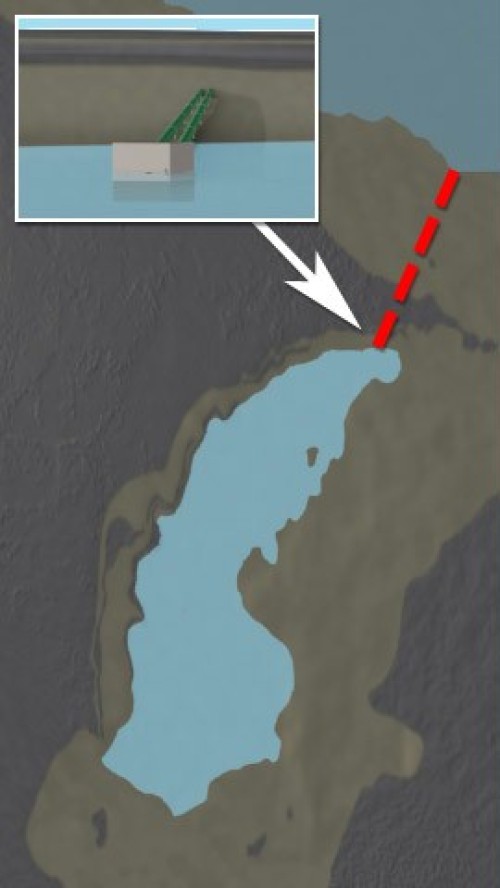Solar pond tower for 5 €ct/kWh
-
21 May 2024
A Solar Pond Tower is a combination of a Solar Tower, a Solar Pond and a
Hurricane Tower, taking the advantages of all of them. The largest advantage comes from the application of the cheap heat generating Solar Pond, which is far cheaper than the large solar heat collecting green house of the Solar Tower. It is estimated that the Solar Pond Tower can produce power at a cost of 3-5 €ct/kWh.
Introduction
The problem of a Solar Tower is that the efficiency is low, though a very large collector area is needed to produce power; for instance a 1000 m high 200 MW tower requires an expensive 20 km² large green house, which causes the main part of the cost.
The problem of a Hurricane tower is that the height is small, so besides a pump a fan is needed to lift the air for the production of fresh water. If integrated in a solar tower no fan is needed and even power is generated, while both the Solar tower and the Hurricane tower can use the same tower.
Instead of a large collector surface the Solar Pond Tower applies the natural collector surface of a lake that is heated by the sun. The lake will also store the heat to apply it during the night or at lower sun shine. For a good efficiency the temperature of the water should be as hot as possible but lower than 100 °C to avoid boiling at the bottom of the lake. To reach this high temperature the water should be insulated, which is natural possible if the lake has a high salt content in a so called salt gradient solar pond. With a high salt content water with a high temperature can contain at saturation more salt and is heavier than water at saturation at a lower temperature realizing a insulating gradient layer. So below a thick insulating gradient layer a hot bottom layer heated by the sun can store heat for several days. The mean temperature of the bottom layer of the pond will be 60 °C and of the cold upper layer 30°C. If the intermediate gradient layer is 0.5 m thick then 30 * 0.6/0.5 = 36 W/m² of heat is lost, which is a loss of only 20% of the incoming solar heat.
Due to this principle high temperatures of 90 °C or more are possible. To generate energy by the chimney effect the Solar Pond Tower should be fed by hot air heated by the hot water of the solar pond. This mechanism is the motor for the big hurricanes in tropical regions causing a lot of kinetic energy and rain but with water of 30 °C, imagine what will happen if the water is 90 °C. Now the Solar Pond Tower provides fresh water as well.

Figure 1: Solar Pond Tower with slowly to and from rotating heat exchanger tube web in the hot bottom layer of the pond
Global description
The Solar Pond Tower will consist of a specific type of cooling tower located in a lake. The inlet air will be heated by hydrophobic heat wheels that are heated by the hot water of the bottom layer of the lake. The inlet air comes over the lake surface and will be saturated by vapor at a temperature of 30 °C, which contains 25 gram water per kg air. After heating, the air will have a temperature of 80 °C and will have a specific mass of 1 kg/m³. Because the specific mass of the air around the tower is 1.2 kg/m³ a pressure difference of (1.2-1)*9.81*1000=1,962 Pa will be generated if the tower height is 1000 m. The kinetic energy generated by this pressure difference is transferred in useful electrical power by turbines. For simplicity in the artist impression axial turbines are presented in the throat of a nozzle shaped tower, which looks rather aesthetic as well. Due to this shape compact turbines can be used. However because the diffuser/condenser has a disk shape maybe a radial turbine is more suitable. Other solar tower concepts apply less compact wind turbines at the tower base. Never the less for further development it should be investigated which turbine type and tower type is most suitable. For a tower with a throat area of 1400 m² and a turbine-efficiency of 60% the net power is 200 MW.
To minimize pressure losses the tower is provided with a concentrator before the turbine and a diffuser behind the turbine to make it possible to exchange heat with the inlet air at a low velocity with low pressure losses. Also at the outlet where the demister is located the air velocity should be low to avoid large pressure losses.
Behind the turbine the air should be mixed with cold outside air to let the original damp at the lake condense in a venturi shaped diffuser which sucks cold air from the environment. At the end of the diffuser the valuable distilled water can be subtracted by a demister.
Due to gravity the damp/air mixture will in its way up decrease in pressure and cool down to 73°C. If further cooled down by mixing with ambient cold air it is assumed that 10% of the original damp can be demist, which is 2.5 gram/kg air or approximately 120 kg/s and 10000 m³/day, which is a lot of fresh water.
To avoid disturbance of the gradient layer between the hot and cold water of the pond the heat will be subtracted by a web of tubes, which sucks water from the cold upper layer from the edge of the area the Solar Pond Tower provide heat. The tubes float in the hot bottom water below the gradient layer of the lake and are secured by floaters. While the water in the tubes flow to the tower by a pump it will be heated by the hot bottom water. To cover the entire area the web of tubes will rotate axially as a wheel and slowly through the bottom layer around the tower.
After the heat is transferred to the inlet air by the heat wheels the water is pumped back to the surface of the lake from where it will flow back to the edge, which closes the cycle.
Because the heat transfer in water is approximately 10 times better than in air the heat wheels turn for 7% in the water and for 70% in the inlet air. They should be corrosion resistant and hydrophobic to avoid evaporation of possible sticking water. Extra evaporation will consume too much heat and will reduce the performance of the Solar Pond Tower. For this reason 23% of the wheel is used to release possibly still present droplets by the centrifugal force of the turning wheels. Heat wheels consume low pressure losses, are compact in heat transfer and rather cheap though very suitable for the Solar Pond Tower. Because normally heat wheels are used for air to air transfer it might not work from water to air, which should be investigated. If not possible another application is the use of Fiwihex, which is compact and cheap as well.
Because the fresh water is generated by the Solar Pond Tower at a height of 1000 m, extra energy can be generated with it by a water turbine of about 2 MW, which is sufficient to drive the water pump and the heat wheels.
The performance of the tower will improve when the tower becomes higher, but the cost will increase as well. In the table below the estimated performances of higher and lower towers with 1400 m² cross section and a required lake area of 20 km² are presented.

Benefits
The benefits of the Solar Pond Tower compared with a Solar Tower are:
- No expensive large green house is needed;
- No storage of sun energy is needed, because the lake already stores an enormous amount of energy;
- Valuable fresh water is generated.
The benefits of the Solar Pond Tower compared with the Hurricane Tower are;
- No expensive fan is needed;
- No expensive heat exchanger for the condenser is required, because heat is exchanged in situ by condensation in direct contact with mixed ambient air.
- Can use the already available tower from the Solar tower
Possible locations
A favorite location for the Solar Pond Tower is a dessert depression with a water inlet as the Death sea where the salt content is already high. A depression is the opposite of a barrier lake but can also generate power if sea water is supplied and evaporated in the depression. An excellent location is Qattara depression in Egypt, where a possible lake level can be around 60 m below sea level. From this level difference with the Mediterranean sea energy can be provided if a canal or tube will connect it. For the Qattara lake a 56 km long canal or tube should be built through the sand hills. In a study it is found that 640 MW of electricity can be generated. Another possibility is to pump water up to hill height in a intermediate reservoir where over complete sun energy can be stored. Then in periods of energy shortage the energy can be recovered by a multiplication factor if the water is led from the intermediate reservoir to the depression lake. With this combination in the same study it is found that up to 2500 MW of electricity can be generated. Due to the inlet of salt Mediterranean water the created lake will soon have a high salt content and besides the energy of the level difference even more energy can be generated by placing Solar Pond Towers.

Figure 5: Possible future Qattara depression lake with detail of salt Mediterranean water inlet by future Qattara hydro plant
Other possibilities for depression lakes or seas are the closing of bays or inland seas by a dike. Also artificial lakes can be used, but will be more expensive, because bottom liners might be required to avoid leakage.
Cost estimate
A rough cost estimate of the 1000 m Solar Pond Tower is 600 M€ (most expensive parts are the tower, turbines and air heater), which will cost 60 M€ /y. If the price of fresh water in the dessert is 25€/m³ this will produce 10000*365*25 = 9 M€/y. Then for the electricity 51 M€ /y is left. With an utilization of 90% totally 200 * 24 *365 *0.9 = 1600GWh of electricity will be produced at a cost of 3 - 5 €ct/kWh. This is so cheap that it will be no problem if the Solar Pond Tower is 2 times more expensive then estimated.
If compared with the 20 km² greenhouse solar collector of a 200 MW Solar Tower, at a rough estimate of 25€/m², 500 M€ will be saved if a Solar Pond Tower is applied. This will already save more than 3 €ct/kWh.
The Qattara depression occupies an area of 18000 km², though 500 Solar Pond Towers of 200 MW can be installed or 100 GW of electricity can be produced, which is a lot of energy enough for 200 million people. Despite the low efficiency of transferring the solar energy that shines on the pond to net electric power, due to the low cost the Solar Pond Tower is very attractive, also if compared with conventional energy sources. Although more efficient energy cycles, like Rankine cycles are available, they are more expensive and requires a lot of environment unfriendly liquids as ammonium or Freon. . For instance the Bet Ha-Arava pond in Israel with 0.2 km² area delivered 5 MW or 25 MW/km², which is more than the 10 MW/km² of the Solar Pond Tower, but compared with the Solar Pond Tower the pond with a sort of Rankine cycle is less cost effective. It needs a large cooling system for the cold side of the cycle as well, which is not the case for a solar tower.
With 500 Solar Pond Towers the Qattara depression will also produce 2000 Megaton of fresh water per year, which is enough for 50 million people.
Critical points
- At locations with high wind the condensation of mist in the condenser might be disturbed;
- The sucked cold air in the diffuser might not sufficient to condense the damp in the outlet air and no mist and fresh water is generated;
- The inlet air might contain salt generated above the lake which will contaminate the fresh water;
- Also droplets still present in the air side of the heat wheel might transfer salt into the fresh water as well;
- The heat wheel might not operate well as a water/air heat exchanger.
- Salt deposition might detoriate the heat exchange of the pond to the tubes.
The first issue is solved if the diffuser is placed at one side of the tower as a yawing chimney cap automatically yawed by the wind. Then the wind will help to provide more ambient cold air and even more fresh water can be condensed.
If the second issue happens it can be tried to take the air from a higher level in the sky or if not possible it is better to skip the fresh water generation and skip the condenser and the demister as well. This will make the kWh price about 15 % higher, which is still feasible.
If the third issu happens the water cycle can be closed by applying double tubes with fresh water, so no back flow in the surface layer of the lake is needed. This will double the pump power but is still feasible.
As already mentioned the fourth issue will be no problem, because then the slightly more expensive alternative Fiwihex or other compact heat exchanger will be used, applied with the closed circuit with clean fresh water.
For the fifth issue preventive maintenance is required by a cleaning robot with a hot fresh water jet.
-
21 May 2024
